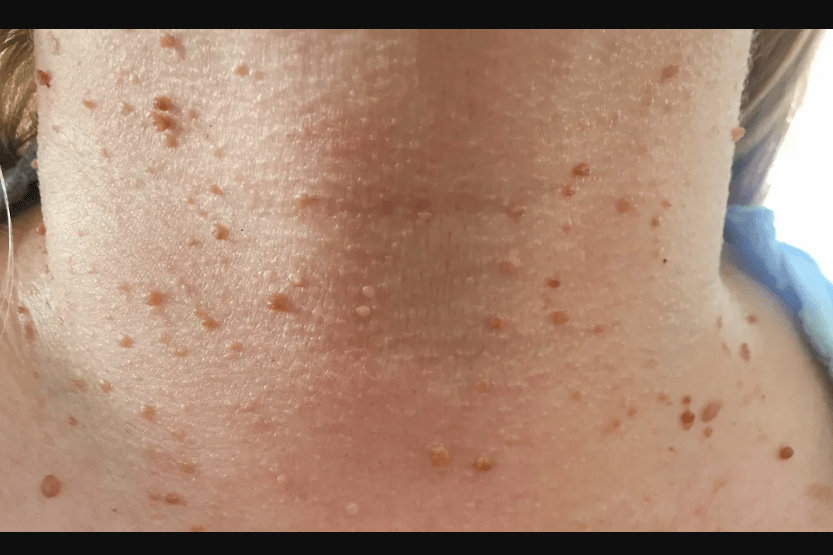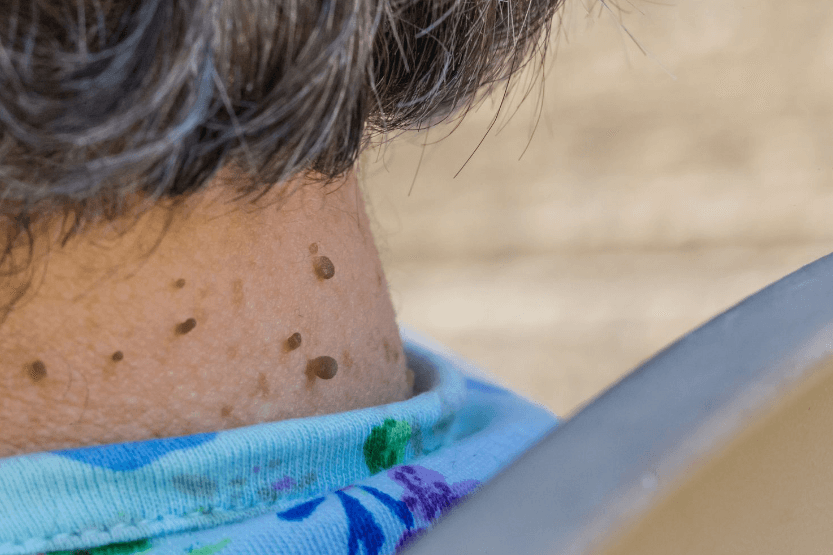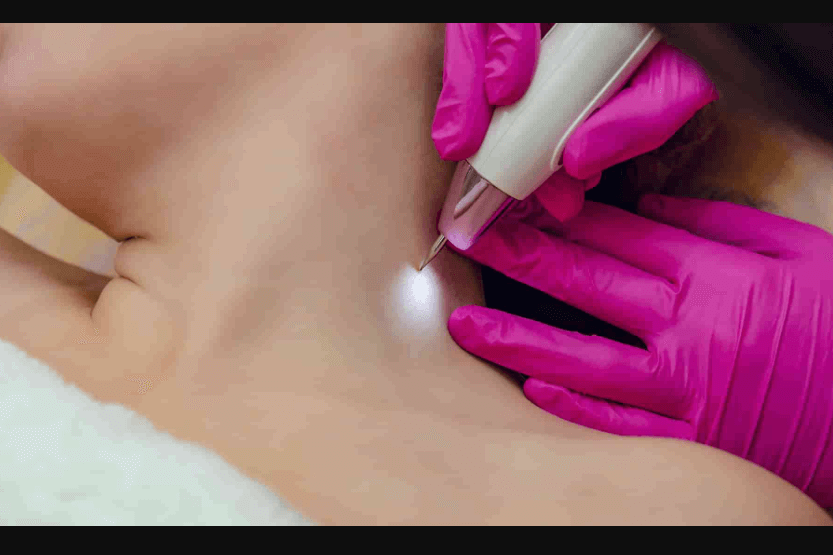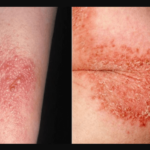Skin tags are small, benign growths that can develop on the neck, as well as other parts of the body.
They are often painless and harmless, but can be bothersome or cosmetically unappealing for some people.
While the exact cause of skin tags is unknown, there are several factors that may contribute to their development. In this article, we’ll talk about the causes, symptoms, and treatments of skin tags.
What are Skin Tags

Skin tags, also known as acrochordon, soft fibroma, or fibroepithelial polyp, are small, benign skin growths that can appear on various parts of the body. They are noncancerous and usually do not cause any pain or discomfort. Skin tags are more common in middle-aged and elderly people, but they can also occur in younger individuals.
Skin tags are usually flesh-colored or slightly darker and can range in size from a few millimeters to several centimeters. They often have a stalk or peduncle that attaches them to the skin’s surface. Skin tags can appear in clusters or individually, and they tend to grow in areas where skin rubs against skin or clothing, such as the neck, armpits, groin, eyelids, and under the breasts.
The exact cause of skin tags is unknown, but they are believed to develop due to friction or rubbing of the skin. People who are overweight or obese, have diabetes, or are pregnant are more likely to develop skin tags. Hormonal changes and genetics may also play a role in their development.
Skin tags are generally harmless and do not require treatment unless they are causing discomfort or cosmetic concerns. However, if a skin tag changes in appearance or color, bleeds, or grows rapidly, it is essential to consult a dermatologist to rule out any underlying health conditions.
Skin Tags and Their Appearance
Skin tags are small, soft, flesh-colored growths that appear on the skin. They are usually benign and do not pose any health risks. Skin tags can occur anywhere on the body, but they are most commonly found on the neck, armpits, groin, and eyelids.
Skin tags are usually small in size, ranging from a few millimeters to a few centimeters in diameter. They are typically flattened and have a smooth texture. Skin tags are usually the same color as the surrounding skin, but they can also be slightly darker.
While skin tags are generally painless, they can become irritated if they are repeatedly rubbed or scratched. In rare cases, skin tags can become twisted and cause a loss of blood supply to the affected area, leading to pain and discomfort.
Skin tags are more common in older adults and people who are overweight or obese. They can also occur during pregnancy due to hormonal changes in the body. In some cases, skin tags may be hereditary and run in families.
Common Locations of Skin Tags

Skin tags can appear in various locations on the body. Although they are more commonly found in areas where skin rubs against skin, such as the neck, groin, and underarms, they can also occur in other areas such as the face, eyelids, back, chest, arms, and skin folds.
Skin tags on the neck are particularly common, and they can be caused by friction from clothing or jewelry, as well as genetics. People who are overweight or have diabetes may also be more prone to developing skin tags on the neck.
Skin tags in the groin area are also common, and they can be caused by friction from clothing or skin rubbing together. They are particularly common in people who are overweight or who have excess skin in the area.
Skin tags on the face and eyelids are less common, but they can still occur. They may be caused by friction from glasses or other objects rubbing against the skin, or they may be a result of genetics.
Skin tags on the back and chest are also possible, and they may be caused by friction from clothing or skin rubbing together. They can also be a result of genetics.
Skin tags on the arms and underarms are less common, but they can still occur. They may be caused by friction from clothing or skin rubbing together, or they may be a result of genetics.
Causes of Skin Tags
Skin tags are small, benign growths that typically occur on areas of the body where skin rubs against skin or clothing. While the exact cause of skin tags is unknown, there are several factors that may contribute to their development.
Age is one factor that may increase the likelihood of developing skin tags. As people age, their skin becomes less elastic, which can lead to the formation of skin tags. Obesity is another factor that may increase the risk of developing skin tags, as excess weight can cause skin folds and creases where tags tend to form.
Pregnancy and hormonal changes may also contribute to the development of skin tags. During pregnancy, hormonal changes can cause an increase in the production of growth factors, which may lead to the formation of skin tags. Similarly, hormonal changes associated with conditions such as diabetes and insulin resistance may also increase the risk of developing skin tags.
Friction is another factor that may contribute to the development of skin tags. Areas of the body where skin rubs against skin or clothing, such as the neck, underarms, and groin, are particularly prone to skin tag formation. Family history may also play a role in the development of skin tags, as they tend to run in families.
Collagen is a protein that helps give skin its structure and elasticity. Changes in collagen production or structure may contribute to the formation of skin tags. Additionally, creases and folds in the skin may provide an environment where skin tags can develop.
Symptoms and When to See a Doctor

Skin tags on the neck are small, benign growths that can appear anywhere on the body, but are most commonly found on the neck area. They are usually harmless and painless, but can be unsightly and cause discomfort if they rub against clothing or jewelry.
Skin tags on the neck are typically small, soft, and flesh-colored or slightly pigmented. They may be flat or hang from a tiny stalk. They can range in size from a few millimeters to a few centimeters in diameter. In some cases, skin tags can become irritated or itchy, and may even bleed if they are accidentally scratched or rubbed too hard.
While skin tags on the neck are generally harmless, it’s important to see a doctor or dermatologist if you experience any of the following symptoms:
- Bleeding or oozing from the skin tag
- Rapid growth or changes in color or shape of the skin tag
- Persistent itching or discomfort around the skin tag
- Signs of infection, such as redness, swelling, or pus
If you have a skin tag on your neck that is causing discomfort or affecting your self-esteem, you may want to consider having it removed. Your healthcare provider can remove skin tags using a variety of methods, including freezing, cutting, or burning them off. However, it’s important to note that skin tag removal is usually considered a cosmetic procedure and may not be covered by insurance.
Diagnosis of Skin Tags
Diagnosing skin tags is usually done through a physical examination by a dermatologist. Skin tags are typically small, soft, and flesh-colored growths that hang off the skin and are usually harmless. However, it is important to distinguish skin tags from other skin conditions such as moles and warts.
Moles are usually darker in color and can be flat or raised, while warts are typically rougher and have a more irregular shape. If there is any concern that a skin growth may be cancerous, a biopsy may be performed to determine the nature of the growth.
In some cases, skin tags may be a symptom of an underlying skin condition, such as Hidradenitis suppurativa or sarcoidosis. If there are multiple skin tags present or they are appearing in unusual areas, it is important to discuss this with a dermatologist to rule out any underlying skin conditions.
Treatment Methods for Skin Tags

Skin tags are harmless and do not require treatment unless they cause discomfort or are cosmetically undesirable. If treatment is desired, there are several methods available to remove skin tags.
Cryotherapy
Cryotherapy involves freezing the skin tag with liquid nitrogen, causing it to fall off a few days after the treatment. This method is quick and efficient and can be done in a dermatologist’s office. However, there is a risk of scarring or discoloration of the skin in the treated area.
Excision
Excision involves cutting off the skin tag with a scalpel or scissors. This method is also quick and can be done in a dermatologist’s office. Local anesthesia may be used to numb the area before the procedure. There is a risk of bleeding and scarring with this method.
Cauterization
Cauterization involves burning the skin tag off with a heated instrument such as electrocautery or electrosurgery. This method is quick but can be painful and may require local anesthesia. There is a risk of scarring and discoloration with this method.
Ligation
Ligation involves tying off the base of the skin tag with a string or suture, cutting off its blood supply, and causing it to fall off. This method is slow and may take several days or weeks for the skin tag to fall off. However, it is a painless method and does not require anesthesia.
Over-the-counter products
There are also over-the-counter products available for skin tag removal, such as creams and ointments. These products work by drying out the skin tag, causing it to fall off. However, these products may take several weeks or months to work, and there is a risk of skin irritation or allergic reactions.
Home Remedies for Skin Tags
While there are various medical treatments for skin tags, some people may prefer to try home remedies before seeking professional help. Here are a few home remedies that may help remove skin tags:
Apple Cider Vinegar
Apple cider vinegar is a popular home remedy for skin tags. It contains acetic acid, which is believed to break down the excess cells that make up the skin tag. To use apple cider vinegar, soak a cotton ball in the vinegar and apply it to the skin tag. Cover the area with a bandage and leave it on overnight. Repeat the process daily until the skin tag falls off.
It’s important to note that apple cider vinegar may cause a stinging sensation and irritation, so it’s essential to dilute it with water before applying it to the skin.
Tea Tree Oil
Tea tree oil is another popular home remedy for skin tags. It has antifungal and antibacterial properties that may help remove skin tags. To use tea tree oil, mix a few drops of the oil with a carrier oil like coconut oil and apply it to the skin tag. Cover the area with a bandage and leave it on overnight. Repeat the process daily until the skin tag falls off.
It’s essential to note that tea tree oil may cause skin irritation, so it’s important to dilute it before applying it to the skin.
Other Home Remedies
Other home remedies that may help remove skin tags include:
- Garlic: Crush a clove of garlic and place it on the skin tag. Cover the area with a bandage and leave it on overnight. Repeat the process daily until the skin tag falls off.
- Banana peel: Cut a small piece of banana peel and place it on the skin tag. Cover the area with a bandage and leave it on overnight. Repeat the process daily until the skin tag falls off.
- Vitamin E oil: Apply vitamin E oil to the skin tag and cover the area with a bandage. Repeat the process daily until the skin tag falls off.
It’s important to note that these home remedies may not work for everyone and that it’s essential to consult a healthcare professional if the skin tag is causing discomfort or if there are any signs of infection.
Prevention and Aftercare of Skin Tags
Prevention is always better than cure, and this is true for skin tags as well. While there is no guaranteed way to prevent skin tags from forming, there are several things that can be done to reduce the risk of getting them.
One of the most important things to do is to protect your skin from the sun’s harmful UV rays. Overexposure to the sun can damage the skin and cause it to age prematurely, which can increase the likelihood of developing skin tags. Wearing protective clothing and using a broad-spectrum sunscreen with an SPF of at least 30 can help prevent sun damage.
Another way to prevent skin tags is to avoid injuring the skin. Scars can increase the risk of developing skin tags, so it’s important to take care of any cuts or wounds properly. Keeping the skin clean and moisturized can also help prevent skin tags from forming.
Maintaining a healthy weight can also help prevent skin tags. Excess weight can put pressure on the skin, which can cause skin tags to form. Eating a healthy diet and exercising regularly can help maintain a healthy weight and reduce the risk of developing skin tags.
While there is no evidence that skin tags are directly related to hormones, some people may experience an increase in skin tags during times of hormonal changes, such as pregnancy or menopause.
Aftercare is also important if you have had skin tags removed. Taking care to prevent infection is extremely important after removing a skin tag. It is not common for a skin tag wound to get infected, but it is possible if the proper care isn’t taken. Immediately after your skin tag is removed, some redness is normal.
To Summarize
Skin tags on the neck are a common occurrence, and there are several reasons why they develop. While they are generally harmless, they can be unsightly and bothersome. Here are some key takeaways to summarize the causes of skin tags on the neck:
- Skin tags are small, benign growths that occur when skin cells and collagen fibers bunch together.
- The most common reason for skin tags around the neck is believed to be skin-on-skin friction.
- Other factors that can increase the likelihood of developing skin tags on the neck include age, genetics, obesity, and hormonal changes.
- While skin tags can be removed by a dermatologist, they are generally not a cause for concern and can be left alone if they are not bothersome.
- Prevention methods for skin tags on the neck include maintaining a healthy weight, practicing good hygiene, and avoiding tight clothing or jewelry that may cause friction.
Overall, skin tags on the neck are a common occurrence that can be caused by a variety of factors. While they are generally harmless, it is important to monitor them and seek medical attention if they become painful, bleed, or change in appearance. By practicing good hygiene and taking steps to prevent skin-on-skin friction, individuals can reduce their risk of developing skin tags on the neck.



![Shades of Brown Skin [20 Common Brown Shades with Chart] shades of brown skin tone](https://skincaregeeks.com/wp-content/uploads/2021/05/shades-of-brown-skin-tone-150x150.jpg)
![Neutral Skin Tone Defined [and Best Colors for Neutral Skin] neutral skin tone](https://skincaregeeks.com/wp-content/uploads/2021/05/neutral-skin-tone-150x150.png)


![Read more about the article How to Get Dead Skin Off Lips [6 Natural Remedies]](https://skincaregeeks.com/wp-content/uploads/2021/04/how-to-get-dead-skin-off-lips-300x200.jpg)

